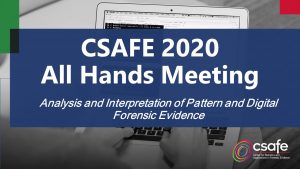Overarching GOALS
CSAFE researchers are undertaking projects to develop objective analytic approaches to enhance the practice of bloodstain pattern analysis. The science that underpins BPA is limited, and two main questions arise: determination of cause and origin. There has been limited analysis of the accuracy of bloodstain pattern analysts in determining the causal mechanism for a particular bloodstain pattern. Laber et al. (2014) describe the results of several studies and find many inconclusive opinions, incorrect mechanisms identified in 10% or more of cases, and the dependence of analyst performance on the context in which they carried out the analysis. During the initial funding period, ISU (Attinger et al., 2018, 2019b) and CMU teams constructed blood spatter databases under controlled conditions and with high resolution. These publicly-available data will be used for developing statistical approaches for assessing cause and origin.
Looking for
WEBINARS,
Short courses, presentations or publications
on Bloodstain Pattern Analysis?
Additional Team Members:
Robert Ramotowski (NIST) robert.ramotowski@nist.gov
focus Areas
Past projects have focused on elliptical-shaped blood stains and defined a number of features for these images. The results are promising but require that more complex-shaped stains that appear in a pattern be ignored. CSAFE’s objective is to develop an approach that will work with stains that are not elliptically shaped by creating an approximation to such stains as the union of a number of elliptically shaped objects.
The current approach to bloodstain pattern analysis is subjective, with experts using their knowledge and training to assess the likely source of the bloodstain pattern and the mechanism that is likely to have produced the pattern. There has been limited analysis of the accuracy of bloodstain pattern analysts in determining the causal mechanism for a particular bloodstain crime scene. In the 2014 final report of their NIJ-funded research project “Reliability Assessment of Current Methods in Bloodstain Pattern Analysis,” Laber et al. report the results of a number of studies. Among their findings: there are a large number of inconclusive opinions, identification of the incorrect mechanism occurs in a substantial (10% or more) fraction of the cases, and strong evidence of context effects. These results suggest that it would be helpful to provide more objective ways of analyzing and summarizing bloodstain patterns.
This project, done in collaboration with bloodstain researcher Michael Taylor of ESR, New Zealand, builds on the approach described in Arthur et al. (2017, Forensic Science International). Those authors focus on elliptical-shaped blood stains and define a number of features for these images. The results are promising but require that more complex-shaped stains that appear in a pattern be ignored. This can lead to situations in which there is not enough data for reliable inference. Our objective is to develop an approach that will work with stains that are not elliptically shaped by creating an approximation to such stains as the union of a number of elliptically shaped objects. A variety of tools from mathematical morphology and statistics can be used to smooth an observed image and fit a series of ellipses to the resulting image. Once this is done for all stains in a pattern, it is possible to define a range of features that focus on the shapes, sizes and orientations of the resulting ellipses. The distribution of various features defined on the ellipses can be used to obtain feature-based likelihood ratios. Recent work, some funded by the initial CSAFE award, has produced publicly available datasets that can be used for this type of work. Once a statistical approach is developed, a critical next step is to identify practitioners who might work with us to demonstrate the approach using historical case-related images. Interactions with practitioners are also critical to assess how statistical methods might be integrated with existing analysis strategies.
Knowledge Transfer
Found 18 Results
Page 1 of 1
Page 1 of 1
Page 1 of 1
Towards a likelihood ratio approach for bloodstain pattern analysis
Type: Publication Research Area(s): Bloodstain,Forensic Statistics
Published: 2022 | By: Tong Zou
In this work, we explore the application of likelihood ratio as a forensic evidence assessment tool to evaluate the causal mechanism of a bloodstain pattern. It is assumed that there are two competing hypotheses regarding the cause of a bloodstain…
A Data-Driven Approach to Model the Generation Process of Bloodstain Patterns
Type: Poster Research Area(s): Bloodstain
Published: 2022 | By: Tong Zou
This poster was presented at the 106th International Association for Identification
Authors’ Response to Commentary on: Liu Y, Attinger D, De Brabanter K. Automatic classification of bloodstain patterns caused by gunshot and blunt impact at various distances
Type: Publication Research Area(s): Bloodstain
Published: 2020 | By: Daniel Attinger
The Commentary by A. Keten makes the case for considering evaporation and coagulation in research and applications of the forensic discipline of bloodstain pattern analysis (BPA). The author also mentions two important facts: first, blood stains are often present in…
A Novel, Data-Driven Approach to the Classification of Bloodstain Patterns
Type: Presentation Slides Research Area(s): Bloodstain
Published: 2021 | By: Tong Zou
Bloodstain pattern analysis is the study of bloodstains at a crime scene with the purpose of drawing inference about the crime. A typical objective for bloodstain pattern analysis is to identify the cause/mechanism that produced the pattern. Examples of possible…
Using the Likelihood Ratio in Bloodstain Pattern Analysis
Type: Publication Research Area(s): Bloodstain,Forensic Statistics
Published: 2021 | By: Daniel Attinger
There is an apparent paradox that the likelihood ratio (LR) approach is an appropriate measure of the weight of evidence when forensic findings have to be evaluated in court, while it is typically not used by bloodstain pattern analysis (BPA)…
Bloodstain Pattern Analysis Black Box Study
Type: Webinar Research Area(s): Bloodstain,Training and Education
This CSAFE webinar was held on October 14, 2021. Presenters: Austin Hicklin Noblis Forensic Science Group, Director Paul Kish Forensic Consultant, Paul Erwin Kish Forensic Consultant and Associates Kevin Winer Director, Kansas City Police Crime Laboratory Presentation Description: This study…
Recognition of Overlapping Elliptical Objects in a Binary Image
Type: Publication Research Area(s): Bloodstain
Published: 2021 | By: Tong Zou
Recognition of overlapping objects is required in many applications in the field of computer vision. Examples include cell segmentation, bubble detection and bloodstain pattern analysis. This paper presents a method to identify overlapping objects by approximating them with ellipses. The…
CSAFE 2021 Field Update
Type: Presentation Slides,Webinar Research Area(s): Bloodstain,Digital,Firearms and Toolmarks,Footwear,Forensic Statistics,Handwriting,Implementation and Practice,Latent Print,Training and Education
The 2021 Field Update was held June 14, 2021, and served as the closing to the first year of CSAFE 2.0. CSAFE brought together researchers, forensic science partners and interested community members to highlight the organization’s achievements, identify areas for…
CSAFE 2020 All Hands Meeting
Type: Webinar Research Area(s): Bloodstain,Digital,Firearms and Toolmarks,Footwear,Forensic Statistics,Handwriting,Implementation and Practice,Latent Print,Training and Education
The 2020 All Hands Meeting was held May 12 and 13, 2020 and served as the closing to the last 5 years of CSAFE research and focused on kicking off new initiatives for the next phase of the center, CSAFE…
Automatic Classification of Bloodstain Patterns Caused by Gunshot and Blunt Impact at Various Distances
Type: Publication Research Area(s): Bloodstain
Published: 2020 | By: Yu Liu
The forensics discipline of bloodstain pattern analysis plays an important role in crime scene analysis and reconstruction. One reconstruction question is whether the blood has been spattered via gunshot or blunt impact such as beating or stabbing. This paper proposes…
Letter to the Editor: Automatic Classification of Bloodstain Patterns
Type: Publication Research Area(s): Bloodstain
Published: 2020 | By: Yu Liu
The forensics discipline of bloodstain pattern analysis plays an important role in crime scene analysis and reconstruction. One reconstruction question is whether the blood has been spattered via gunshot or blunt impact such as beating or stabbing. This paper proposes…
Feature-based analysis of bloodstain patterns
Type: Webinar Research Area(s): Bloodstain
A key task in the analysis of bloodstain pattern analysis is to identify the mechanism by which the stains were created. Examples include impact, gunshot, castoff, and expiration. This webinar will introduce how images of bloodstain patterns can be represented…
Pattern Evidence Research in CSAFE-An Update
Type: Webinar Research Area(s): Bloodstain,Firearms and Toolmarks,Footwear,Handwriting,Latent Print
CSAFE is a NIST Center of Excellence in Forensic Science. A large portion of CSAFE’s research portfolio is on what is known as pattern evidence, which encompasses any evidence that can be represented as an image. Examples of pattern evidence…
Determining the region of origin of blood spatter patterns considering fluid dynamics and statistical uncertainties
Type: Publication Research Area(s): Bloodstain
Published: 2019 | By: Daniel Attinger
Trajectory reconstruction in bloodstain pattern analysis is currently performed by assuming that blood drop trajectories are straight along directions inferred from stain inspection. Recently, several attempts have been made at reconstructing ballistic trajectories backwards, considering the effects of gravity and…
A data set of bloodstain patterns for teaching andresearch in bloodstain pattern analysis: Gunshot backspatters
Type: Publication Research Area(s): Bloodstain
Published: 2019 | By: Daniel Attinger
This is a data set of blood spatter patterns scanned at high resolution, generated in controlled experiments. The spatter patterns were generated with a rifle or a handgun with varying ammunition. The resulting atomized blood droplets travelled opposite to the…
A data set of bloodstain patterns for teaching and research in bloodstain pattern analysis: Impact beating spatters
Type: Publication Research Area(s): Bloodstain
Published: 2018 | By: Daniel Attinger
This is a data set of 61 blood spatter patterns scanned at high resolution, generated by controlled impact events corresponding to forensic beating situations. The spatter patterns were realized with two test rigs, to vary the geometry and speed of…
Letter to the Editor: Automatic Classification of Bloodstain Patterns Caused by Gunshot and Blunt Impact At Various Distances
Type: Publication Research Area(s): Bloodstain
Published: 2020 | By: Yu Liu
The forensics discipline of bloodstain pattern analysis plays an important role in crime scene analysis and reconstruction. One reconstruction question is whether the blood has been spattered via gunshot or blunt impact such as beating or stabbing. This paper proposes…
Hydrodynamics of back spatter by blunt bullet gunshot with a link to bloodstain pattern analysis
Type: Publication Research Area(s): Bloodstain
Published: 2017 | By: P.M. Comiskey
A theoretical model describing the blood spatter pattern resulting from a blunt bullet gunshot is proposed. The predictions are compared to experimental data acquired in the present work. This hydrodynamic problem belongs to the class of the impact hydrodynamics with…
Page 1 of 1
COMMUNITY CALL-TO-ACTION
Want to collaborate with CSAFE on a project. Contact us to share your idea.






